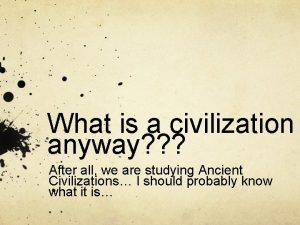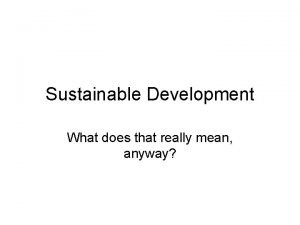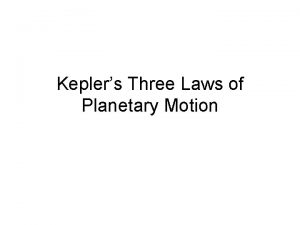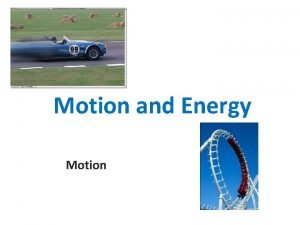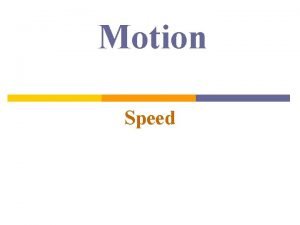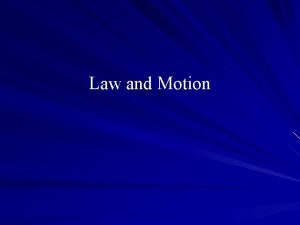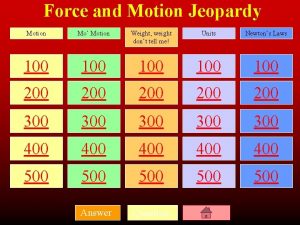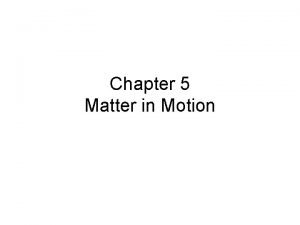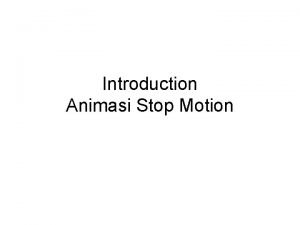Motion What is motion anyway Motion is a



















- Slides: 19

Motion

What is motion anyway? Motion is a change in position, measured by distance and time. n Anything moving is in motion. n

Distance How can I find out how far I’ve gone? n Distance = speed x time n If I drove 3 m/s for 10 seconds, how far have I gone? n 3 m/s X 10 s = 30 m

What changes motion? Force!! F = mass x acceleration n A force is a push or pull that can change motion n A force can move an object A force can transfer energy to an object n For example, pushing on a wall doesn’t move the wall, but energy is being transferred.

Unbalanced Forces In order for a force to move an object, there must be unbalanced forces. n Like tug of war…the winners are pulling the other team with more force; therefore the pulling forces are unbalanced. n

How can force affect motion? Resistance forces (friction or wind) that oppose motion can slow down motion. n A force in the same direction can speed up motion. n

Speed We talk about speed everyday. n Speed is the distance traveled by a moving object per unit of time. n Speed affect the energy of an object. The faster it moves, the more kinetic energy it has. n Speed = distance time n

Kinetic Energy – Energy of Motion Speed and mass affect the kinetic energy of an object. n If two objects are moving at the same speed, but one object has a greater mass, then the object with the greater mass will have more kinetic energy. n The more mass in an object, the more force needed to move it. n

Velocity and Speed are like fraternal twins- very similar, but with important differences. n Velocity is speed in a given direction. n n n 35 mph NORTH 4 km/sec EAST

Which is which? 100 m/s right n 1500 km/s n 65 m/s north n 3000 km/s n Velocity Speed

Acceleration n Acceleration is the rate of change in speed. Acceleration = Change in speed (m/s) Time (s) n Example: 0 to 60 mph in 3 s n

Example The race car accelerated from stop to 60 m/s by the finish line. It took the racecar 8. 0 seconds to finish. What was the acceleration? Original speed = 0, Final speed = 60 m/s, Time = 8. 0 seconds Acceleration = 60 - 0 m/s = 7. 5 m/s^2 8. 0 s

Friction is a force that opposes motion. n Can be caused by wind, water, surface texture, etc. n

Resistance Force Have you ever ridden down the street on your bike and felt the wind push against you? n That’s air resistance! n Air resistance is the frictional force from the air that resists forward motion n

Momentum is the property that a moving object has because of its mass and velocity. n All moving objects have momentum. n n Momentum = mass x velocity

Sir Isaac Newton n Isaac is famous for his discovery of gravity. He is also known for his three laws that explain all aspects of motion.

Newton’s First Law n An object at rest will remain at rest, and a moving object will remain at a constant velocity unless unbalanced forces act on it. ** Inertia- is the term used to describe the tendency of an object to remain in motion or stay at rest.

Newton’s Second Law n Motion produced by unbalanced forces. n The units of force are “Newtons” 1 N = 1 kg x m/s s 1 N is the force on a 1 kg mass that will accelerate that mass at 1 m/s 2. n

Newton’s Third Law n For every action, there is an equal and opposite reaction.
 Whose water is it anyway
Whose water is it anyway Whos taylor swift anyway
Whos taylor swift anyway What is a civilization anyway
What is a civilization anyway Anyway the thing is what i really mean
Anyway the thing is what i really mean What is intelligence anyway by isaac asimov
What is intelligence anyway by isaac asimov So what are you anyway
So what are you anyway Whose life is it anyway analysis
Whose life is it anyway analysis What is constitution? *
What is constitution? * Whos line is it anyway
Whos line is it anyway Describing motion section 1 answer key
Describing motion section 1 answer key Chapter 2 motion section 1 describing motion answer key
Chapter 2 motion section 1 describing motion answer key An object in motion stays in motion
An object in motion stays in motion Section 1 describing motion
Section 1 describing motion Chapter 2 section 1 describing motion answer key
Chapter 2 section 1 describing motion answer key Range of motion types
Range of motion types Measuring motion
Measuring motion Harmonic motion equation
Harmonic motion equation 3 laws of planetary motion
3 laws of planetary motion Passive and active rom
Passive and active rom What is continuous motion in dynamics
What is continuous motion in dynamics


